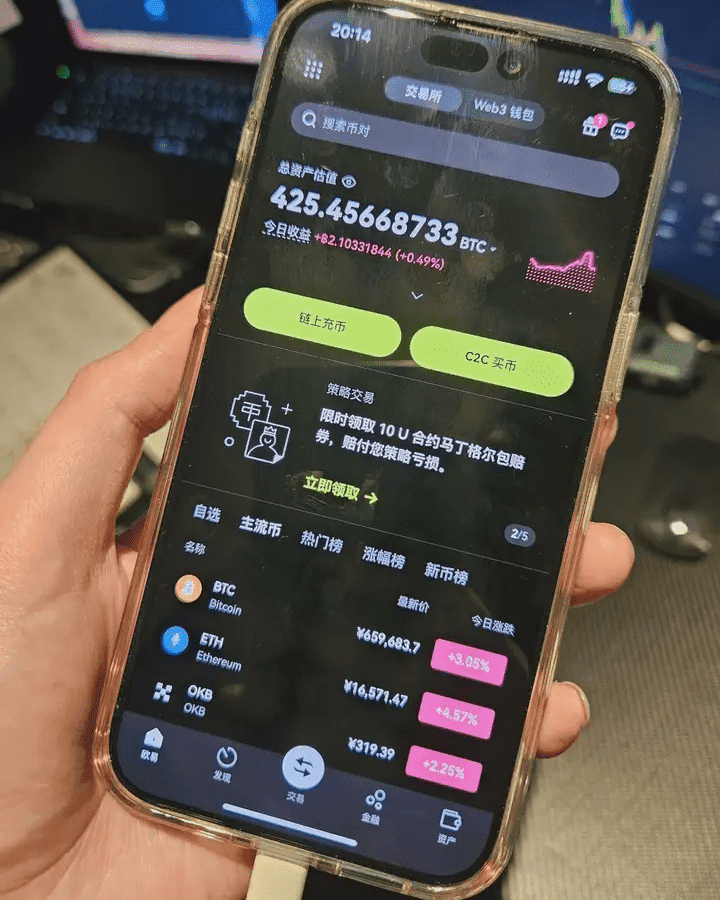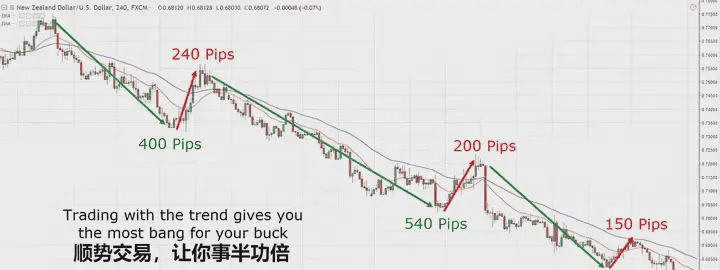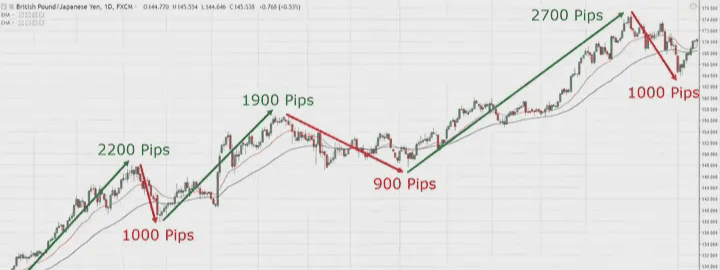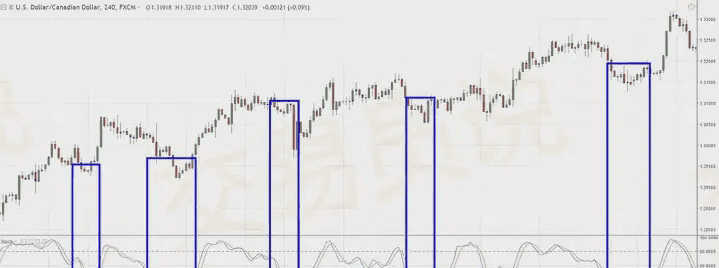Many people disdainfully say that those who have made big money in the cryptocurrency space through several cycles are gamblers with luck. Let me state a truth: Don't be jealous; those who gain substantial wealth in the cryptocurrency space and hold onto it are not lucky, so don't be unconvinced.
I won't talk about how many traps existed in ancient times; those were undoubtedly much more thrilling than now. Just focusing on today, those who have made significant money and held onto it have certainly mastered their actions regarding their large positions, perfectly avoiding all the following matters:
1. Open contracts
2. Bought a lot of non-Bitcoin.
3. Put all coins in exchanges
4. High-frequency trading, attempting to buy high and sell low.
Do not underestimate these four things. If you do not deeply focus on the cryptocurrency space, you will not understand. Those who can make big money in the cryptocurrency space must have focused deeply on it and have been continuously trading in the space—these people can adhere to the above four principles after making significant profits, indicating they have likely suffered significant losses in the aforementioned matters.
, and still accumulate large funds in the cryptocurrency space through means other than the aforementioned gambling methods. Would you call that luck?
Most people in the cryptocurrency space have only 'made money once' because their pathways to making money are limited to the above few options, and naturally, they will also lose because of these. Once a person understands that the aforementioned paths cannot truly lead to wealth but cannot find other methods to become wealthy in the cryptocurrency space, that is the real issue.
Let me tell you, those who truly made money in the cryptocurrency space and have preserved it long-term, in addition to not stepping into the traps mentioned above, must comply with at least one of the following conditions:
1. There is a flagship product in the cryptocurrency space
No matter how aware you are, you will step into the above traps and lose the coins you should lose. But the key is, you have a product that allows you to continuously earn money in the cryptocurrency space. This product serves to recover the lost coins, regardless of how many traps you have stepped into. As you become smarter, you stop stepping into those traps, and your coins will increase more and more—representatives like CZ and Brother Sun have all stepped into these beginner traps, but the key is that they have products to help them continuously earn coins back, while you do not. This is the crux.
2. Have the ability for continuous dollar-cost averaging
If you do not have the ability to create products, then the easiest thing for you to match is this. Stop saying 'Bitcoin won't increase much more'; this is not a reason for you to gamble with large positions—when has Bitcoin ever run fast? Bitcoin was low in the past, but that was compared to now. The Bitcoin of that time and the altcoins of that time were both the slower ones; where are those altcoins now? Give yourself 10 years to gradually invest the money you earn over the next decade, allowing the money you earn in these 10 years to multiply by 5 or 10. This is the best way for ordinary people to open up in the cryptocurrency space.
The premise here is to have a good locking mechanism that only allows entry and not exit; a good dollar-cost averaging environment—not investing just because you have money today or skipping it when you don’t. If you think it is very low, you invest heavily; if you think it is too high, you can choose not to invest. You also need excellent off-market investment capability—your ability to make money greatly enhances the aforementioned rules.
The above premises are indispensable. A person can have the ability to make waves outside the market but can still enter the market and be humble and obedient—that in itself is a remarkable person, and this money is what you deserve.
3. The coins are locked
I participated in an ancient fund where the coins were locked for 5 years. During this time, the cryptocurrency space experienced many ups and downs, but this money was locked and could not be moved. Were there times in reality when I needed to access the funds? Of course, there were. During this time, I also bought a house. When investment returns were delayed, and I needed to invest in other projects, I even temporarily turned to banks. Later, the coins I had dwindled during the ups and downs of investment and entrepreneurship, but when the fund distributed profits, I found that the total shares added up to several hundred Bitcoins—although the fund did not outperform the time when this money was directly used to hold coins, the issue was that I truly could not hold it. The percentage of coin loss in this fund was far less than the portion I held myself.
In the cryptocurrency space, such things happen frequently; some loser bought coins and ended up in jail due to violence, and after getting out, became a billionaire—this is not a story, it's reality. If he hadn't gone to jail, he would have lost all those coins long ago.
Since then, I have actively locked the largest share of Bitcoin and have kept it locked until now. If you believe in Bitcoin, exchange everything you have for Bitcoin now, actively lock it for 10 years, and then start from scratch. After 10 years, the result is likely to exceed what you achieve by doing all the other seemingly more useful things during these 10 years.
Once again, I have never seen any big player become a big player by trading coins; not one—trading coins cannot make you a big player, and leverage cannot either. There is no such thing as luck in the cryptocurrency space. Your understanding of it must be in place first; then it can become your best wealth-building tool, or else you will become its slave.
After over 10 years of trading coins and experiencing four bull-bear cycles, I can say that truly holding onto wealth, being a steadfast believer in Bitcoin, and being a staunch holder of Bitcoin will naturally bring wealth closer to you!
 Currently, there are three types of people making money in the cryptocurrency space.
Currently, there are three types of people making money in the cryptocurrency space.
The first type of person treats coins as assets, holds a bit honestly, and usually does not pay attention; even in a bull market, they do not look. They treat their coins as an asset, buying only a little. They may earn 120,000 a year and spend frugally, saving 30,000 to invest. Their mindset is excellent, and they buy major coins. They do not concern themselves with various positive and negative news in the cryptocurrency space, nor do they want to. They understand deeply that caring more does not equal getting more; such concern is ineffective. After two cycles of bull and bear markets, their annual investment of that little amount results in their assets growing to over ten million. This is a path that ordinary people can take, but achieving it is not easy. These individuals possess a profound understanding of their own ignorance, thus never do anything. They adhere to their capability circle, pursuing a universally applicable bright path.
The second type of person really relies on luck, listening to news in the market, making various friends, and having various hot sector events. Sometimes they lose, sometimes they earn, but when the bull market comes, they might buy into a target and suddenly make tens of millions. I have seen this around me; some can exit in time, convert the coins into real assets, and preserve most of it, while others eventually return to the cryptocurrency space. They want to earn other people's money without considering contributing to the cryptocurrency space. They merely want to make a quick buck. When the market is abundant, they might get a bit of luck, but if the market dries up, their assets will be entirely taken by the market. This is luck in the market cycle. I have also earned money by luck and know how important it is to understand what you know. It's crucial to leave in time and convert the money earned into assets that allow you to walk a bright path. However, achieving this is extremely difficult. What anyone says is of no use; people can't teach others; experience will teach you everything.
The third type of person relies on strength and character; the cryptocurrency space is their ATM. They can launch projects and collect tokens, they can also lead and follow trends to make big money. They play everything, with trading as the main theme. They primarily do USD-based trades and are satisfied watching their USD grow. They don’t trust holding onto a single asset for long-term; only increasing their USD counts as profit. Such people can make money in both bull and bear markets. Of course, when they encounter losing projects, they can exit immediately. This distinguishes them from other newcomers. They see profitable projects and do not exit after earning a little; they understand that the logic of rising has not ended. They do not look at prices or say a certain coin is too high to exit; they have no such thoughts. Their minds are filled only with logic. Once the logic ends, they exit. Their subjective biases align with market development trends, making them very impressive. This is the realm of achieving 'a sharp sword with no edge,' where they all end up making big money.
So which type do you want to be? The third type is the hardest to achieve; it requires a lot of effort, along with your character and emotional worldview in the cryptocurrency space. The second type relies on luck, whether difficult or easy; it is predetermined. The first type is the simplest, but many people do not believe that making money can be that easy, so this becomes a path with the least competition and the simplest.
The first type of person never argues with others. The second type relies on luck and competes with others, and the third type competes with strength; since it is competition, there are winners and losers.
In the cryptocurrency space, the core secret to achieving financial freedom and earning tens of thousands of U daily: The ultimate guide to high-probability trading—A complete system from strategy building to practical implementation.
Share this with everyone, and remember to bookmark it!
Do you want to find high-probability trading opportunities?
Do you want to develop your own high-probability trading strategy?
I believe you want to, otherwise you wouldn't have clicked on this article.
But the problem is... you are not sure what to do.
You are not focusing on the price but are looking at indicators (without understanding their purpose).
You are not following the trend, but trying to predict market reversals.
You have not done proper risk management and instead placed a large bet because this trade 'felt right.'
Now... if you are doing any of the above, then identifying high-probability trading opportunities will be difficult.
But don't worry.
I have good news to share with you.
Because in this article, I will teach you step by step how to find high-probability trading opportunities.
Here is what you will learn:
✅ Why trend trading can increase your returns and reduce risks
✅ How to find the best trading areas on the chart
✅ How to trade pullbacks, breakouts, and failed test patterns.
✅ How to set reasonable stop losses to avoid being 'stopped out' too early.
✅ A high-probability trading strategy that allows you to profit in both bull and bear markets.
Alright, let's get started...
Trends let you achieve more with less effort
The definition of a trend is as follows:
◎ Uptrend: Composed of higher highs and higher lows.
◎ Downtrend: Composed of lower highs and lower lows
If you want to find the path of least resistance, look to the left (and follow the trend).
You should maintain a long position when the price is in an uptrend. When the price is in a downtrend, you should maintain a short position.
By trading with the trend, you can see that driving movements (green) are more favorable to you than corrective movements (red).
Here are a few examples:


Now you might be wondering: Identifying trends seems simple, but how do I enter an already existing trend?
This is what we will discuss next...
How to identify value areas on the chart
You may have heard the saying: 'Buy low, sell high.'
But no one asks the question: What is low, and what is high?
This is where support and resistance come into play.
Support and resistance
Here are their definitions:
Support—an area with potential buying pressure pushing the price up (value area in an uptrend)
Resistance—an area with potential selling pressure pushing the price down (value area in a downtrend)
This is what I mean...


Dynamic support and resistance
What you saw earlier was the classic support and resistance (horizontal lines) I mentioned.
Alternatively, it can also appear in the form of moving averages. This is known as dynamic support and resistance (I use 20 and 50-period exponential moving averages).
This is what I mean...


Support and resistance not only allow you to trade from value areas but also improve your risk-reward ratio and win rate.
Another 'trick' you can use is the overbought/oversold indicators.
High-probability trading—using stochastic indicators to identify value areas
A major mistake most traders make is to go short or long merely because the price is overbought or oversold.
Because in a strong trend market, the market may remain in an overbought or oversold state (if you trade without a stop loss, you may lose your entire account).
This is what I mean:
Now you might be wondering: How do I use the stochastic indicator to identify value areas?
In an uptrend, you only look for long opportunities when the price is oversold.
In a downtrend, you only look for short opportunities when the price is overbought.
Here are some examples:


If you follow this simple rule, you can usually 'predict' when the pullback will end.
So, you have learned how to identify value areas on the chart.
Now, you will learn how to better grasp the timing for entering a trade.
How to enter a trade
There are three ways to enter a trade:
1. Pullback
2. Breakthrough
3. Failed tests
Pullback
A pullback refers to the price temporarily moving in the opposite direction of the potential trend.
In an uptrend, a pullback refers to the price moving downward.
Advantages of trading callbacks:
◎ You can obtain good trading positions because you are buying in value areas. This provides you with a better risk-reward ratio.
◎ You can better control risk because the stop-loss position is clearer.
Disadvantages of trading callbacks:
◎ If the price does not enter the area you identified, you may miss the opportunity.
◎ You may be trading against potential momentum.
Breakthrough
A breakout refers to the price moving beyond a defined boundary.
Boundaries can be defined by classic support and resistance.
Upward breakout:

Downward breakout:

What are the pros and cons of trading breakouts?
Advantages of trading breakouts:
◎ You can always capture the market.
◎ You are trading in accordance with potential momentum.
Disadvantages of trading breakouts:
◎ Your trading position is poor.
◎ You may encounter many false breakouts.
How to set a stop loss
I will share two methods with you:
1. Volatility stop loss
2. Structural stop loss
Volatility stop loss
Volatility stop loss considers market volatility.
The indicator for measuring volatility is the Average True Range (ATR), which can help you set stop losses.
You need to determine the current ATR value and multiply it by the coefficient you choose, such as 2ATR, 3ATR, 4ATR, etc.

In the example above, the ATR is 71 points.
Therefore, if you want to set a stop loss of 2ATR, calculate 2*71 = 142 points.
Your stop loss is 142 points away from the entry point.
Advantages:
● Your stop loss is based on market volatility.
● This is an objective way to define how much 'buffer space' you need for your entry point.
Disadvantages:
● It is a lagging indicator because it is based on past prices.
Structural stop loss
Structural stop loss considers the market structure and sets the stop loss accordingly.
For example: Support is the area from which the price may rise. In other words, it is a 'barrier' that prevents the price from falling further.
Therefore, it makes sense to set the stop loss below the support. Resistance is the opposite.
This is what I mean:
You want to set the stop loss in a structured place in the market, where these structures can act as your 'barrier.'
Advantages:
● You can clearly know when you are wrong because the market structure has been broken.
● You are leveraging the 'barriers' in the market to prevent the price from hitting your stop loss.
Disadvantages:
● If the market structure is larger, you need a wider stop loss (which will lead to a smaller position size to maintain constant risk).
What is convergence, and how does it affect your trades?
The reality is as follows:
You won't enter a long position just because the stochastic indicator is oversold or the market is in an uptrend.
You need additional 'supporting evidence' to provide you with entry signals. This 'supporting evidence' is called convergence.
Convergence refers to two or more factors giving the same trading signal. For example, the market is in an uptrend, and the price pulls back to the support area.
Here are two guiding principles:
1. No more than four convergence factors
The more convergence factors you have, the higher your probability of trading success. However, in the real world, your trading strategy should contain 2 to 4 convergence factors.
If you exceed this number, you may get very few trading opportunities. Moreover, your advantage may take a long time to work.
You can accept moderate trading opportunities and still make money in the long term.
2. Do not have multiple convergence factors within the same category.
If you plan to use indicators (oscillators) to identify overbought/oversold areas, then only use one.
Do not add stochastic indicators, RSI, and CCI at the same time, as this will paralyze your analysis. Similarly, adding simple moving averages, exponential moving averages, and weighted moving averages to the chart at the same time is also meaningless.
If you have persisted in reading this far, you will gain something. Because what comes next is the most valuable part.
A high-probability trading strategy that allows you to profit in both bull and bear markets.
This is my secret (which you just learned)...
◎ Trend trading
◎ Trade in value areas
◎ Find entry points
◎ Set a stop loss
◎ Plan your exit
If a trade meets these five conditions, then for me, it is a good trade.
Now, let's learn a new trading strategy that can provide you with high-probability trading opportunities.
Are you ready?
● If the 200-day moving average is trending upwards and the price is above it, then it is an uptrend (trend trading).
● If it is an uptrend, wait for the price to pull back to the support area (trade in value areas).
● If the price pulls back to the support area, wait for a failed test to enter (my entry trigger condition).
● If there is a failed test, enter a long position at the opening of the next candlestick (my entry trigger condition).
● If entering a trade, set the stop loss below the candlestick low and take profit at the nearest swing high (my exit and profit target).
The opposite is true for a downtrend.
How to develop a high-probability trading strategy (a template you can use)
You can 'mix and match' different trading techniques I previously shared with you.
But ultimately, your trading strategy needs to answer the following seven questions:
1. How do you define a trend?
You can consider moving averages, trend lines, structures, etc.
2. How do you define a value area?
You can consider dynamic support and resistance, weekly highs/lows, stochastic indicators, etc.
3. How do you enter?
You can consider pullbacks, breakouts, failed tests, moving average crossovers, etc.
4. How do you exit?
There are many exit strategies.
5. How much risk are you willing to take on each trade?
I recommend that the risk for each trade should not exceed 1% of the account to avoid bankruptcy risk.
6. How do you manage trades?
Will you gradually reduce or increase your positions? If so, by how much?
7. Which markets will you trade?
Are you focusing on one market or multiple markets? If you are trading multiple markets, you need to understand the correlations between them.
If you can confidently answer these seven questions, you are on the path to developing your own high-probability trading strategy.
What strategies are there for holding coins in the cryptocurrency space?
There is a phenomenon in the cryptocurrency space where traders account for a large proportion, while holders are few. However, in the end, those who can genuinely profit in the cryptocurrency space are often these holders.
Essentially, trading coins is about buying and selling for price differences through short-term trades, while holding coins is about recognizing the investment value of a particular coin, continuously buying in and waiting for appreciation.
Due to the low threshold for trading coins, it is relatively easy to get started and quickly profit, so most investors, especially beginners, prefer trading coins over holding coins. This phenomenon is also prevalent in the entire investment market, where short-term trading is the choice of most people.
Once you taste a bit of success, you become obsessed with trading coins. People inherently have a gambler's mentality; after earning a little, they become overly confident and increase their positions. In contrast, after losing a little, they become anxious all day, their mentality nearly collapses, falling into a vicious cycle where the only outcome is to cut losses and exit.
Holding coins requires more technical skills; you need to have a correct judgment and understanding of the market conditions. Once you pinpoint the right timing to hold, subsequent profits can be quite considerable, although the transition from bear to bull markets may take a long time, requiring patience. Today, the instructor will talk about what strategies exist for holding coins.
First, do not hold too many types of coins; try to keep it under six types, ideally holding three to four super mainstream coins that are unlikely to die in the next few years. If you really can't choose or don't know how to choose, just hold Bitcoin.
Second, holding coins should be moderately diversified; do not hold only one type. You can choose three to six types to avoid the occurrence of black swan events.
Third, when holding coins, reference the types held by those big players, as they have some value in reference. Many of these big players have been in the game since 2012 or 2013 and have experience.
Fourth, the method of holding coins should preferably involve dollar-cost averaging, starting to dollar-cost average during Bitcoin's long-term low-volume consolidation or at the beginning of a rounded bottom, trying to avoid downtrends.
Fifth, when holding coins, maintain a pessimistic expectation. Holding coins in the bear market or initial phase of a bull market is about buying the dips. Therefore, keep a long-term perspective for the big harvest in two years. Thus, try to use spare money that does not affect your life. Even Bitcoin has the potential to drop 40% to 80%. However, as long as you are holding Bitcoin, there will be a day when it rises back.
Sixth, do not use leverage to hold coins or use very little leverage. The current centralized exchange contracts are filled with unfair practices and insider trading. Coin holders should not use leverage, as it is easy to face sudden liquidation. If you must use leverage, do so with spot trading.

The three things long-term holders should avoid the most
1. Entering at too high a price.
To hold long-term, a good mindset is very important. If it's not a dollar-cost average but a one-time high-position build-up, no matter how you comfort yourself as a long-term investment, it's hard to dispel the anxious feelings before the paper loss.
2. Self-doubt, giving up halfway.
Every bear market, the number of people entering the market is particularly low. Even if Bitcoin's asset value 'halves' or even 'drops significantly,' far fewer people are willing to buy Bitcoin at $3,000 compared to those willing to buy it at $10,000. Dollar-cost averaging also faces torment. The main issue in this situation is not the bear market but whether the entry decision is a result of your own thinking or if it was based on the 'success stories' of big players or friends. For long-term investors, it is essential to have your own opinion, execute according to your plan, and not be afraid to swim against the current. You must assess the situation and incorporate your understanding into your judgment, ultimately validating your cognition through actions.
3. Improper storage, lost keys.
There are many long-term holders who eventually forget their private keys. Although Bitcoin is valuable now, millions of Bitcoins have been lost for various reasons and are difficult to retrieve.
The difference between trading coins and holding coins is similar to the difference between short-term and long-term stock trading. If you have a good outlook on a stock, holding it long-term has less risk than short-term trading. Long-term holding of Bitcoin is likely to be profitable. Short-term carries much greater risk and can easily lead to total loss. This is why it is said that 'trading coins is not as good as holding coins'; trading coins is secondary market short-term trading, while holding coins is about buying low and selling high in the secondary market.


